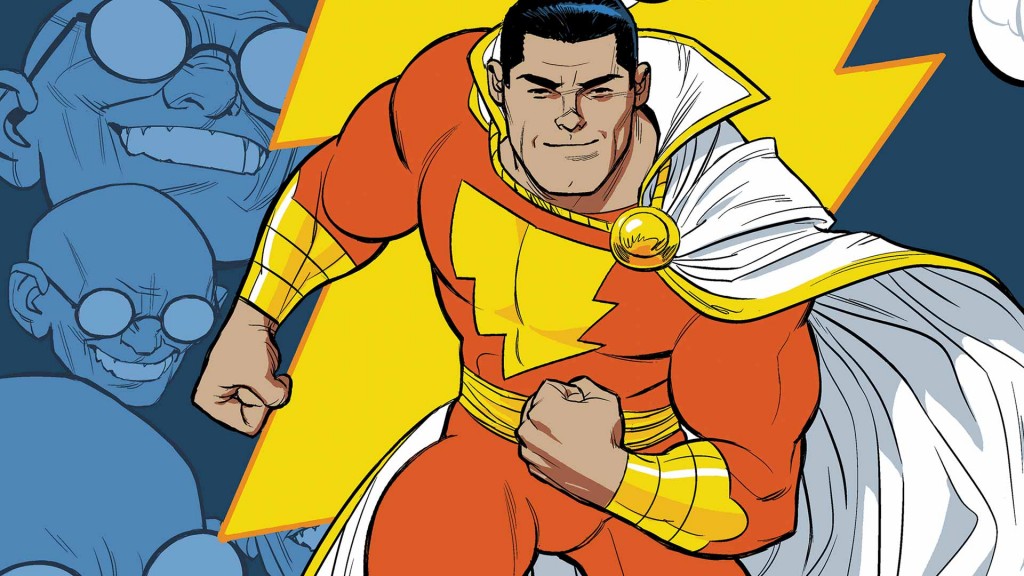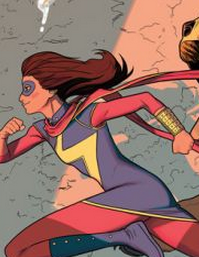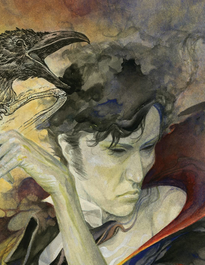Deadshirt Is Reading… is a weekly feature in which Deadshirt’s staff, contributing writers, and friends-of-the-site offer their thoughts on Big Two cape titles, creator-owned books, webcomics and more. For more of our thoughts on this week’s new comics, take a look at Wednesday’s Deadshirt Comics Shopping List.
Dom, Joe, Jason, and Max are reading…
In this month’s Multiversity Roundtable, Deadshirters Dom Griffin, Joe Stando, Jason Urbanciz, and Max Robinson fine-tuned their vibrational frequencies and shared their impressions of the installment out this week.
The Multiversity: Thunderworld Adventures #1
Written by Grant Morrison
Art by Cameron Stewart
DC Comics
“One word of advice. Don’t look away from the man with two strong arms–and you at either end of them!“
Max: After the full-fledged steak dinner that was Pax Americana, this month’s Multiversity outing was a welcome mid-course palette cleanser. Thunderworld, set on an Earth that’s more or less a modern take on the original CC Beck Captain Marvel comics, is distinctly lighter fare. Morrison’s plot is the perfect level of silly that Captain Marvel comics should be; the Drs. Sivana of multiple Earths team up to create an eighth day of the week called “Sivanaday” and finally beat the forces of good, and it’s up to Billy Batson and his friends to stop them. From a gang of Sivanas “heh-ing” menacingly in unison to the conversion of the Rock of Eternity into a drab office building, Morrison lays down some really quality gags that Stewart makes sing. So far each issue of Multiversity has detailed a different alternate DCU’s own private apocalypse, it’s fitting that Thunderworld is the one that has the most fun with it.
Jason: It’s appropriate that the month after the heaviness and dread of Pax Americana we get Thunderworld, the most gentle and shining issue of The Multiversity. Dr. Sivana, communicating with his multiverse counterparts he discovered via the Society of Super-Heroes comic, builds his own Rock of Eternity and endeavors to defeat Captain Marvel and his associates on the one day that evil can win on Earth-5, the new eighth day! Sivanaday! What follows is a fun clash between bright superheroes and their devious counterparts. This is an interesting book in the course of The Multiversity. It’s the first one in which Ultra Comics #1 doesn’t appear. Usually that comic is the source of the Gentry’s evil spreading throughout the multiverse. It could be that Ultra Comics is something too evil to even exist on a pure world like Earth-5. Even the villain, Dr. Sivana, is clearly grossed out by some of his counterparts. This comic’s success hinges on the art, and Cameron Stewart and Nathan Fairbairn deliver. It’s just so bright and clean, and some of the textures that Fairbairn adds to the backgrounds (especially on the spread where Cap crosses over from Earth to the Rock of Eternity) give the book a real three-dimensional heft.
Dom: It’s sweet that Morrison and Stewart’s Pixar take on Captain Marvel is the first issue of Multiversity to have a happy ending (insofar as Pax Americana had no ending at all), but you can’t help but wonder if this is the idealistic calm before the storm. The primary forces battling here, the cold calculation of science and the hopeful mystery of magic, represent warring perspectives on the future of genre fiction. Do we nail everything down with quantifiable explanations and hyperreal interpretations of fantastical material, or do we trust in the magic words, the nebulous feelings that keep us safe and allow us to keep dreaming? Judging off the passive aggressive derision Sivana’s scientist is depicted with, it’s clear Grant has chosen his side. Have you?
Joe: Everyone’s summed it up pretty well already, but Thunderworld was a welcome break from the density and pathos that have defined a lot of Multiversity so far. It’s a light, fun story, perfectly in keeping with its characters. It’s also maybe the funniest issue so far, and unlike the other laugh riot book The Just, everything here is kind and in good humor (although Mary Marvel’s “I wonder if I’d be very different at all” in another universe is some excellent shade thrown at the character’s misuse by DC). I know Morrison has said that each Multiversity issue could function like a backdoor pilot to an ongoing line, but this is probably the first story that’s left me yearning for more. Stewart and Fairbairn are a great team, and I’m glad they had such a fertile world to shape. I’ve reread Pax Americana and loved it, but that’s a sort of a challenge and academic exercise. Thunderworld is pure comfort food, just the way a Captain Marvel story should be.
Sarah Register is reading…
Written by G. Willow Wilson
Art by Adrian Alphona
Colored by Ian Herring
Lettered by Joe Caramagna
Marvel
“Heroing: Never what you think it’s gonna be.”
Kamala Khan was a breakout star in the Marvel U this year, but it’s not until her final issue of 2014 that she becomes the unofficial hero of the Millennial generation. Ms. Marvel finally has her chance to rescue a gaggle of teens from the wacky mutant birdman, The Inventor, only to discover that they willingly want to be a part of his sadistic plan (thanks to a bit of brainwashing). Kamala learns a pretty big lesson in “heroing” in that sometimes you have to convince someone that they’re worth saving.
Everything about Adrian Alphona’s art that works so well with Ms. Marvel’s vibe is evident in this issue, from the teens’ recognizable street fashion to the physical comedy in every fight scene. Lockjaw, an incredibly powerful member of the Inhumans (currently undercover as a teen girl’s pet), is adorably drawn as a giant pug with an impossibly wide mouth, despite being a ferocious ally. Alongside her alien canine, Kamala’s facial expressions and body language range from fierce passion to Looney Tunes physics as she successfully fumbles her way through a rescue mission.
The Inventor has been an interesting foil to this new, plucky superhero. He doesn’t so much brainwash teens as exploit the way they are labeled by adults, pointing out that if certain terms used against the youth were applied to any other minority group, it would be considered hate speech, making him a bad person but a strangely insightful antagonist. Despite being a crazy supervillain who steals a girl’s dog (honestly like the worst thing to do to a kid), he’s capable of teaching Kamala about the complexities of being a hero. The issue ends up almost (but not quite) preachy about the value of today’s youth despite society’s tendency to dismiss them completely. Kamala speaks almost directly to her readers, instilling value in them and encouraging them to tackle head on all the issues the future brings. I’m a bleeding heart, so loved this issue, but anyone rooting for comics with female leads should be reading Ms. Marvel.
Joe Stando is reading…
Scarlet Spiders #2
Written by Mike Costa
Art by Paco Diaz
Colored by Israel Silva
Lettered by Travis Lanham
Marvel
Spider-Woman #2
Written by Dennis Hopeless
Art by Greg Land (pencils) and Jay Leisten (inks)
Colored by Frank D’Armata
Lettered by Travis Lanham
Marvel
This week’s “Spider-Verse” installments are the second issues of books I didn’t get to cover in quite as much detail because of Thanksgiving. It’s too bad, too, since neither issue is as good as its respective premiere, although one is close. The other… well, it’s not great.
Scarlet Spiders is a book with a really fun premise: a trio of Peter Parker clones from various universes team up on a suicide mission to Loom World, the Inheritors’ home base reality, in an attempt to destroy the Inheritor scientist Jennix’s cloning lab. The three of them have strong chemistry: alternate Ben Reilly is written in the most jokey, irreverent style possible, Kaine is still brooding and violent, and Ultimate Jessica Drew balances between fun and naïve and clever and capable. The problem is that they don’t get a ton to do here. There’s some solid fights and banter, but they don’t cover a whole lot of new ground after finding the cloning lab and running into Jennix, who’s hanging out in the lab like a Resident Evil boss. I did like a chilling little interaction between Jennix and a mindwiped/semi-lobotomized iteration of Dr. Miles Warren, but this issue felt a lot lighter than the first. Hopefully there will be more to the third and final issue than just a fight in which someone dies (my money is actually on Kaine, since New Warriors tanked so hard the team ended up as cannon fodder in the first chapter of “Spider-Verse”), since there’s a lot to appreciate here.
Spider-Woman is a less promising. The first issue was decent; Silk is still kind of an irritating character, but Anya (Spider-Girl) and Spider-Gwen showed up towards the end, and Land’s art was relatively inoffensive. I’d sort of hoped that this initial “Spider-Verse” crossover would feature all those characters in various roles, spotlighting a group of “Spider-Women.” This isn’t the case. Instead, Anya and Gwen are nowhere to be seen, and Silk is just jumping between universes (which does give us our first hint of a total weakness of the Inheritors, albeit one of questionable use: they can’t survive a nuclear holocaust). Meanwhile, Spider-Woman herself ended up in Loom World as well, doing some general recon and spying to help prep for an attack by the Spider-Army. It seems her counterpart here is wealthy and revered, by virtue of being Morlun’s concubine. This is kind of a gross plot point, but sadly, since 95% of Spider-Woman’s deal is gross male gaze-y bullshit, it fits right in. Land’s artwork takes a dive, with Spider-Woman looking more and more frequently like a traced nude figure with some details drawn on. I think a lot of it, particularly the Morlun reveal, is supposed to be played for laughs, but it’d take a more competent artist to get that across.
I’m sort of interested in both books this week ending up in Loom World (presumably the endgame will take place here, but is it going to start that soon?) but overall, Spider-Woman is kind of a mess of a book. I think it’s telling that when I like the books, I tend to focus more on the characters and beats, but an issue like this takes me right out and I analyze it like an inferior product, as opposed to a real story.
Kayleigh Hearn is reading…
Written by Neil Gaiman
Art by J. H. Williams III
Vertigo
“I understand too much. Can I tell you a story?”
The Sandman is one of the crown jewels of western comics, and The Sandman: Overture is a gleaming new facet to that jewel. Whenever Neil Gaiman returns to his classic Vertigo series, which he has done occasionally since it concluded in the 1990s, there’s a slightly cynical worry that it will be a disappointment. Surely he’s out of new Sandman stories to tell? Issue 4 refutes that idea: this is pure Sandman, a complex and literary work that ultimately challenges the label of “prequel.”
Overture is technically a prequel, in that it chronicles the events that happened directly before Sandman #1, but “prequel” feels limiting for what is a very non-linear story. Though the central plotline about Dream investigating an insane, sentient star takes place in the early 1900s, the series has jumped backwards and forwards throughout time, and even included a cameo from Daniel, Dream’s future incarnation. As the insane star threatens all of creation, the rules of time and space break down, often with the effect of scenes in different time periods “bleeding” into each other. A character grows old, then young, during one conversation on a single page. An important meeting takes place between “two microseconds.” This is a challenging issue that will probably require multiple reads, but with its peculiar notion of time, this is the Sandman story that feels most like a dream.
SPOILERS AHEAD
The biggest surprise of the comic is the matter-of-fact way Gaiman introduces a new member of the Endless family: their father. Though readers have known of the seven Endless siblings for decades (and a few of the Endless were parents themselves), the revelation that the personifications of universal concepts have parents is a new wrinkle in the story. Dream visits his father’s realm for help, but in typical Endless family fashion, he receives little. His father and mother aren’t named, but my guess based on clues in their conversation and the imagery in his realm, “father” and “mother” are Father Time and Mother Nature.
J.H. Williams’s artwork is astoundingly, jaw-droppingly, words-failingly gorgeous. The story is told mostly in a series of double-page spreads that abandon traditional panels and gutters. Following the characters as they move along borderless, intricately-designed pages, the reader is swept along with Gaiman’s non-linear portrayal of time. Williams’ art invokes Jim Steranko, Alphonse Mucha, and M.C. Escher, but also feels wholly original and alien. This is, without hyperbole, career-defining work. Gaiman and Williams are perfectly matched in what is a beautiful and challenging example of comic books as an art form.
Thanks for reading about what we’re reading! We’ll be back next week with a slew of suggestions from across the comics spectrum. In the meantime, what are you reading? Tell us in the comments section, on Twitter or on our Facebook Page!






